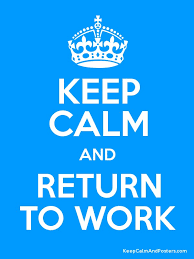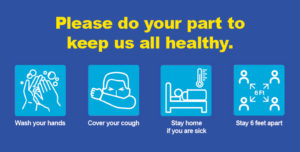COVID-19 and Getting Back to Work | Leap Solutions Group, Inc.

During the current COVID-19 pandemic, every day brings new information, concerns, and challenges regarding the spread of the virus, its economic and social impacts, and government directives. Leap Solutions remains dedicated to keeping you informed and empowered by delivering relevant, up-to-the-minute information and resources.
Our HR specialists are here to help you get a handle on the complexities of ever-changing guidelines, programs and legislation that may directly impact you and your employees as well as work with you to come up with practical solutions and smart planning decisions for your organization’s immediate, near and long-term needs.
In this issue of our newsletter we will cover:
- Preparing to reopen? Here’s what you should do ahead of time, including training for employees
- Communicating with your employees, clients, and customers
- What to do if someone doesn’t want to return to the workplace
- Facilitating social distancing
- Reconfiguring work schedules
- Guidelines for clients and customers
- Promoting worker hygiene
- Developing a plan to quickly respond to a COVID-19 diagnosis, symptom report, or exposure
- Being prepared for future impacts of COVID-19 to your business
After weeks of being closed or partially open, with many of their employees furloughed, laid off, or working from home, businesses everywhere are getting ready to get back to work. Following are Leap Solution’s recommendations to help make the transition go as smoothly as possible. If you need assistance implementing these recommendations, we are here to help.
Preparing to reopen? Here’s what you should do ahead of time, including training for employees
- Train and inform everyone on your staff about the actions they will need to take once they are back onsite to help ensure their safety and the safety of everyone around them, including your clients and customers.
- Document these actions in writing as your COVID-19 Prevention Plan. Have employees sign the plan, designating that they understand it, and will abide by it.
- Ensure social distancing can be accomplished when you are open. See the sections on Facilitate social distancing and Reconfigure work schedules
- Identify a point person on your staff to keep track of, understand, and communicate changes in health and safety guidelines from OSHA, CDC, state and local government agencies, and others.
- Determine the type(s) of health screening and/or testing you will implement.
- Decide what health and safety items you will require, such as facemasks, and under what circumstances. Be sure to check your local county website for specific COVID-19 requirements.
- Determine what job positions need to be done onsite, and which ones can be accomplished at home. Update your telecommuting policy with explanations and justifiable reasons why certain jobs require employees to work onsite. If you don’t have a telecommuting policy, this is a good time to create one. For the job positions that must be onsite, communicate the business reason with your entire workforce.
- Review your sick leave and time off policy. Consider some flexibility to allow employees to stay home, if they show any signs of illness.
- Make hand sanitizer and cleaning supplies available throughout the workplace to promote safe hygiene.
- Intensify workplace cleaning and disinfection – have a plan for cleaning common areas and frequently touched surfaces at least once per day.

Communicate! Communicate! Communicate!
- Let employees know the plan for re-opening – what the company is doing to prepare for it, and what will be expected of them.
- Detail what new workplace safety and disinfection protocols have been implemented.
- If any policies, benefits, job duties, etc. have been created or changed since sheltering in place, be sure to let employees know in writing.
- Keep an eye out for any unequal treatment of employees in granting flexible work schedules or telework arrangements. Advise managers and others that such benefits should not be granted on the basis of a protected status, including gender.
- Explain how staying home if sick and physical distancing will be used to protect employees, clients, and customers.
- In case COVID-19 exposure should occur after reopening, have a communication plan ready to go.
- Listen to and be prepared to address employee concerns and questions before and after reopening. Have regular video or phone check-ins with employees to ensure they are engaged, feel supported, and are able to meet your expectations, whether they are working from home or in the office.
- Be alert for pandemic-related harassment and train managers to recognize it and address it. Consider issuing a statement reminding your workforce that any type of harassment is not tolerated in the workplace.

What can you do if someone doesn’t want to return to the workplace?
Some employees will be eager to get back to the workplace, while others may have health and safety concerns. If an employee has apprehensions about returning to work or refuses to return to the workplace altogether, inquire about their reasoning. Listen to their concerns and respond with understanding and flexibility.
Following are some possible responses and actions that you can take:
- “I’m afraid.” – Assure them with the steps the business is taking to keep the workplace clean and safe for everyone. Ask how you can support their return to work.
- “I am earning more on unemployment.” – Their refusal to return to the workplace based on their unemployment check is considered a resignation on their part. Be sure to document your conversation. Request that their decision not to return to work and their reasons why be made in writing and place it in their personnel file. You must also notify the California Employment Development Department that your employee refused available work.
- “I am at high risk, or I live with someone who is high risk.” – Review the Americans with Disabilities Act to see if they may need an accommodation. Determine if they qualify for emergency paid sick leave under the Families First Coronavirus Response Act, or unpaid, job-protected leave under the Extended Family Medical Leave Act. Employers are not required to provide accommodations to employees relative to their family member’s at-risk status under the ADA; however, it is recommended that employers issue guidelines about whom to contact in the organization to request accommodations or other flexibilities in working arrangements.
- “I don’t have anyone to watch my children.” – Determine if they qualify for the Families First Coronavirus Response Act or the Extended Family Medical Leave Act. Request the appropriate documentation from them that you will need.
Facilitate social distancing
- Revise workspace layouts and seating arrangements to allow for social distancing of at least six feet.
- Redesign conference rooms, lunch rooms, and other common areas to provide more distance between individuals. Limit the number of people allowed in a common area at any one time.
- Limit in-person meetings. Instead, encourage employees to use the phone, online meetings, or e-mail to conduct business, even if they are in the same building.
- If available, create or designate an outdoor area with well-spaced tables for lunch and other breaks.
- Use physical barriers, if needed, such as plexiglass between employees and customers.
- Revise work paths to facilitate social distancing, such as one-way aisles and floor markers in retail establishments and manufacturing facilities.
- Redesign production lines to increase space between employees.

Reconfigure work schedules
- Reconfigure work schedules and/or job shifts to limit the number of employees physically present in a specific office, facility, plant, or other work location at any one time.
- Implement work from home arrangements for job positions where it is feasible, either full-time or part-time.
- Stagger meal periods and rest breaks, consistent with applicable law. Consider requiring or asking that employees eat at their work area, rather than common areas.
Guidelines for clients and customers
- Your company website and social media sites are great ways to provide updates to customers and clients about the steps you are taking to prevent the spread of COVID-19.
- Provide clear, visible guidelines for how customers should interact with your employees and one another. Train your employees to reinforce those guidelines. For example, you may limit the number of customers in your business to 10 at any one time, with customers asked to wear facemasks and stay at least six-feet distance from one another.
- Use video conferencing with clients, customers, and vendors, if feasible, rather than in-person contact.
- Lock doors or have other security measures in place, so that vendors and others on company property will not be able to enter your facilities without authorization.
- Anyone working at your business should have a clear understanding whenever operations change, so they can act accordingly and share appropriate information with clients and customers.

Promote worker hygiene
- Display posters in common areas with reminders of how to properly wash hands and other ways to prevent the spread of viruses, such as “cover your cough” and “avoid touching your face.”
- Have protective supplies readily available for employees, such as non-medical cloth masks, hand sanitizer, gloves, disinfectants, and possibly face guards or shields, depending on the type of business you have.
- Ask employees to avoid using each other’s phones, desks, offices, work tools, and equipment.
- Prohibit on-site food preparation and food sharing.
Develop a plan to quickly respond to a COVID-19 diagnosis, symptom report, or exposure
- Identify a point person or task force to oversee your response to a COVID-19 incident.
- Make sure employees know whom to notify and how, should they receive a COVID-19 diagnosis, have symptoms, or if they have been exposed to someone with COVID-19.
- Develop a protocol in the event of a report of a confirmed or possible employee with COVID-19, such as sending the employee home. Note: CDC guidance currently permits essential workers with potential exposure to remain in the workplace, if certain steps are taken.
- Develop a protocol for a temporary shutdown and deep cleaning of the workplace, if necessary. Know ahead of time who will do the cleaning and what additional measures you will take when reopening. The need for your business to shut down may come with little or no advance notice.
Be prepared for future impacts of COVID-19 to your business
- Be prepared in the event that a large number of employees need to take sick time or other leaves of absence at the same time.
- Be prepared for another business shutdown or partial shutdown, due to government orders or a second wave.
- Be prepared for the possibility of future employee layoffs, temporary furloughs, wage and hours reductions, or other measures.

Leap Solutions is a diverse group of highly skilled management, organizational development, and human resources professionals who have spent decades doing what we feel passionate about: helping you feel passionate about what you do. Our HR specialists can help you get a handle on the ever-changing COVID-19 guidelines, programs, and legislation that may impact you and your employees. We are available to work with you to develop practical solutions and smart planning decisions for your organization’s immediate, near, and long-term needs.
Click here to print this newsletter.

![]()

